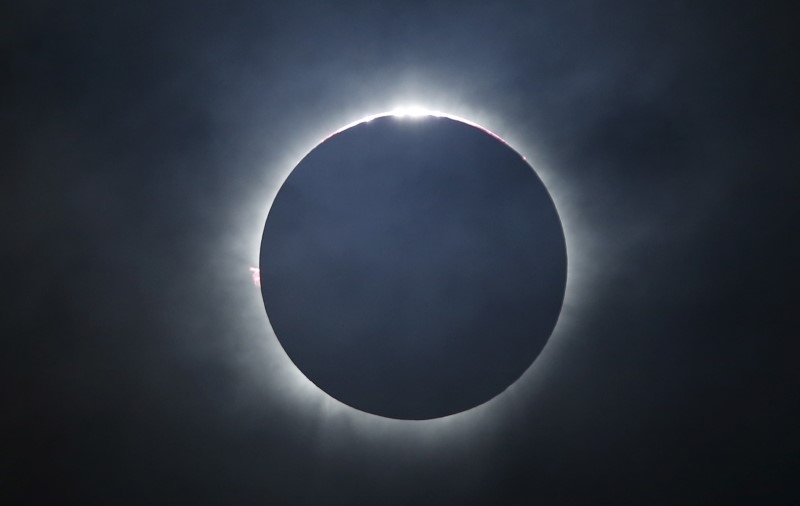Tens of thousands of tourists flocked to cities and towns across northern Chile to stake out spots in one of the world’s best locations to witness Tuesday’s total solar eclipse.
Millions are expected to gaze at the cosmic spectacle that will begin at 10:24 a.m. local time in the South Pacific and sweep along a path 6,800 miles across open waters to Chile and Argentina, the only places that the total eclipse will be seen aside from an uninhabited island out in the ocean.
The eclipse is expected to make its first landfall in Chile at 3:22 p.m. in La Serena, a city of some 200,000 people where the arrival of more than 300,000 visitors forced the local water company to increase output and service gas stations to store extra fuel. Police and health services were also reinforced.
The total eclipse will begin there at 4:38 p.m. and last about 2½ minutes.
“I came to La Serena to watch the total eclipse with a friend following a recommendation,” said Stephanie Bouckurt from the United States. “They told me that nothing compares to a solar eclipse, so that’s why we’re here. We’re super excited.”
Northern Chile is known for clear skies, and some of the largest, most powerful telescopes on Earth are being built in the area, turning the South American country into a global astronomy hub.

The town of La Higuera will also be plunged into total darkness.
“We hope this milestone will transform (our town) into a tourist attraction, so that visitors … can come to La Higuera and take a picture where there once was a total sun eclipse,” Mayor Yerko Galleguillos said.
Town officials distributed more than 2,000 cardboard-frame protective eyeglasses at local schools and community centers while workers built statues of huge sunglasses and a darkened sun on a local square.

“These glasses are going to give (students) the opportunity to protect themselves and witness this spectacle that we’ve all been waiting for so eagerly,” said Alejandra Zuñiga, director of the Juan Pablo Muñoz school in La Higuera.
Astronomy Lovers Can Live Stream the Event
No need to break out the eclipse glasses this year (unless you live within the path of totality): Astronomy lovers can live stream Tuesday’s total solar eclipse over South America from the comfort of just about anywhere with WiFi.
Here are a few options:
The Exploratorium museum in San Francisco is partnering with NASA to live stream the eclipse as the moon moves between the Earth and Sun to block the Sun’s light, leaving areas in its path in darkness for four and a half minutes.
Their coverage begins Tuesday at 3 p.m. ET across three channels: one for live telescope views from an observatory in Vicuna, Chile, and two more for commentary in English and Spanish. NASA Television will also carry the English-language coverage on its channel.
The European Southern Observatory will stream its own live coverage of the event from its facility in the Atacama Desert in Chile. Reservations are full for in-person observatory viewing.

The eclipse will be visible in its totality in a narrow 70-mile radius from La Serena, Chile, to Buenos Aires, Argentina, between 4:38 p.m. and 4:44 p.m. ET.
Along with Argentina and Chile, Ecuador, Peru, Bolivia, Paraguay and Uruguay will experience a partial solar eclipse, as well as parts of Colombia, Brazil, Venezuela and Panama, according to NASA.
August 2017 marked the last time all of North America caught a glimpse of a total solar eclipse. The path of totality ran from Oregon to South Carolina—the first time in 99 years a total solar eclipse crossed the Atlantic and Pacific.

‘Relatively Rare’
A solar eclipse occurs when the moon passes between the Earth and the sun and scores a bull’s-eye by completely blocking out the sunlight.
“It’s going to be very dark and we’re going to have a Milky Way in its full splendor,” said Chilean astronomer María Teresa Ruiz. “I invite you to look at hundreds of thousands of stars.”
Thousands of visitors also trekked to neighboring areas of Argentina where the eclipse also will be total.

The San Juan provincial government installed telescopes and public viewing areas. Meanwhile, astronomers in Buenos Aires province planned to offer yoga and meditation classes during the eclipse, which will also be partially visible in other South American countries.
The CNN Wire contributed to this article.


